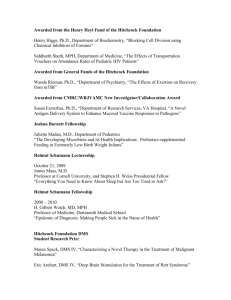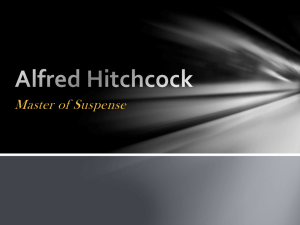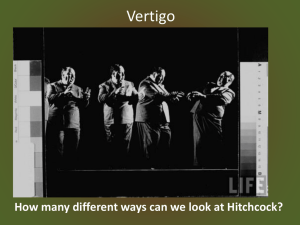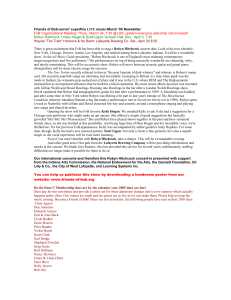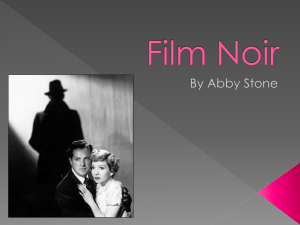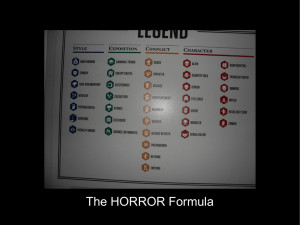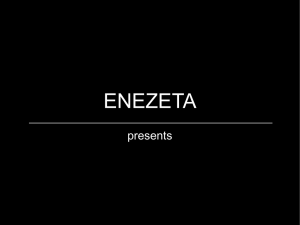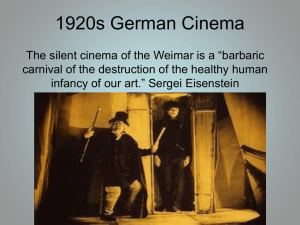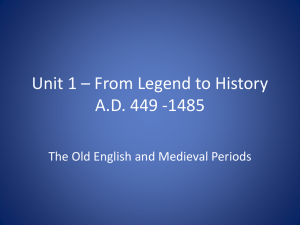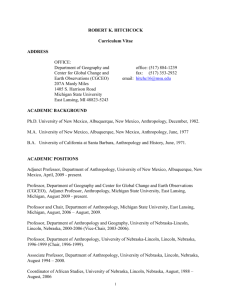Hitchcock lecture 1
advertisement
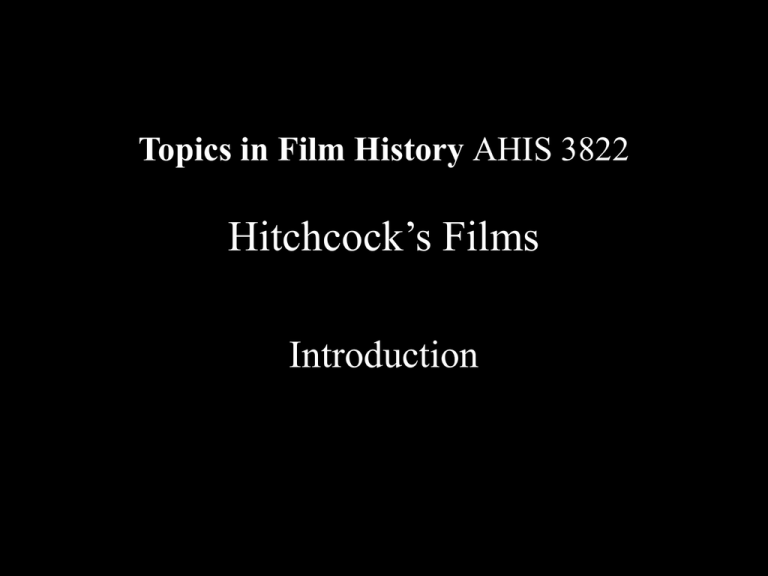
Topics in Film History AHIS 3822 Hitchcock’s Films Introduction “It’s all in the details.....” (Alfred Hitchcock) Description The course will provide students with a critical survey of the films of Alfred Hitchcock. Through lectures, screenings and selected readings students will be introduced to a wide range of material on Hitchcock’s life and work, with particular focus accorded his canonical position as a major auteur within the history of film. Approaches Various theoretical, methodological and critical discourses associated with contemporary film studies will also be discussed, among them: auteurship, structuralism, psychoanalysis, feminism, social historicism, socio-economist, narratology, cognitive studies, reception theory, deconstruction and queer studies. Week 1 Introduction: Course Overview: bibliography, assignments, expectations etc: Screening: The Lodger (1927) Assignment #1. In class film report (continuous, 15%). Required Texts Cohen Tom, Hitchcock’s Cryptonymies Volume 1 Secret Agents and Volume 2 War Machines University of Minnesota Press 2005 (Available in NSCAD U Bookstore) Recommended Sloan, Jane E. Hitchcock: The Definitive Bibliography L.A. University of California Press Allen, R and Gonzales, S. Ishi Alfred Hitchcock: Centenary Essays: London, British Film Institute 1999 Spoto, Donald. Alfred Hitchcock: The Dark Side of Genius N.Y. Ballantine, 1983 Gottlieb, S (Ed) Hitchcock on Hitchcock Selected Writings and Interviews: L.A. University of California Press Stam, R. Burgoyne, R and Flitterman Lewis, S. New Vocabularies in Film Semiotics: Structuralism, PostStructuralism and Beyond N.Y. Routledge 1994 Mast, G. Cohen M and Braudy L Film Theory and Criticism Introductory Readings 6th Edition Oxford University press 1998 Course Reader: Hitchcock’s Film Theory: Reading Theory through Hitchcock. Recommended Websites http://faculty.cua.edu/johnsong/hitchcock/pages/biblio.html Hitchcock bibliographies. http://www.tdfilm.com/ The Definitive Alfred Hitchcock Resource http://www.labyrinth.net.au/~muffin/ Alfred Hitchcock Scholars MacGuffin website, associated with The MacGuffin critical journal http://alfredhitchcock.directorscut.info/ AlfredHitchcock.com http://www.hitchcock.nl/ "Hitchcock Online" http://www.videouniversity.com/hitchcock.htm http://www.labyrinth.net.au/~muffin/ “Everything's perverted in a different way.” – Alfred Hitchcock Hitchcock interview with Ian Cameron and V.F. Perkins, Movie, #6, January 1963, pp. 4–6. Reprinted in Sidney Gottlieb (ed.), Alfred Hitchcock Interviews, University Press of Mississippi, Jackson, 2003, p. 51 “ Jimmie Stewart and Kim Novak in Vertigo (1957) A-H Life details Born. August 13, 1899, London, England Died. April 29, 1980 at age 81 in Los Angeles, USA. He was third and last child of an East End family whose father William ran a poulterer's and greengrocer's business and whose mother Emma came of Irish stock Catholic working class (lower middle class). Bio details • Father dies in 1915,. • AH leaves St Ignatius a Jesuit School to help out with the family grocery business. • Attends night classes in navigation, mecahnics and drafting at University of London. • 1915 Begins work at the Henley Telegraph Company while continuing his night classes in art history, economics, political science, drawing and illustration. Hitchcock cameo in Young and Innocent (1937) • Hired to Henley's advertising department. • 1917 fails Army medical exam and excused from military service. Enlists in th volunteer Royal Engineers • Short Story Gas published in Henley's staff magazine • 1920 takes samples of his ad and illustration work to Players Lasky, U.S. film company branch in London. • 1923 Meets future wife Alma Reville a writer and film editor. • 1923 Set designer for two successful films Woman to Woman and The Passionate Adventure • Works for Gainsborough Film Co. (1924) and sent to Germany to UFA studios to meet and observe F.W. Murnau filming the Last Laugh • 1925 His boss Michael Balcon assigns H to first Directors position on The Pleasure Garden (1924) and The Mountain Eagle (1926) AH directing The Mountain Eagle (1926) Class 1 For many sociologists class, like ideology, is one-dimensional: one's class is objectively located and established on the basis of certain discrete criteria and relatively autonomous categories and indicators such as: education, occupation and income. Class 2 For others however, class is contextual, dynamic and "resonates with political meaning." (McNall, et al., 1991:3). E.P. Thompson's landmark study The Making of the English Working Class (1963), argued that a class may participate in its own making as much as it is made, (class as relational as distinct from oppositional, although the differences between the two are often difficult to locate. Class 4 In other words, the individual classed subject comes to know and understand his/her class position only in terms of their opposition to others, and this is signified (represented), through various means as a relation of power. Early literary influences Charles Dickens: A Christmas Carol; Great Expectations; Oliver Twist; David Copperfield; Little Dorrit Edgar Alan Poe: The Raven; The Tell Tale Heart Gustave Flaubert: Memoirs of a Madman (1838; Mémoires d’un fou; November (1842); Madame Bovary (1857);Salammbô (1862) Oscar Wilde: Picture of Dorian Gray Thomas De Quincey: Murder as one of the Fine Arts G.K. Chesterton: The Man Who Was Thursday (1908) Orthodoxy (1908) The Ballad Of The White Horse (1911) poetry; Manalive (1912); Father Brown short stories (detective fiction); Eugenics and Other Evils John Buchan: The 39 Steps Hitchcock’s Early Films Of the nine silent films Hitchcock directed, all but one — The Mountain Eagle (1926) — survives. Of the eight surviving films, only six have appeared on home video (The Pleasure Garden (1925) and Downhill (1927) mysteriously have been neglected). Five of those films have been released on DVD including Easy Virtue (1927). A User’s Guide to “Hitchcock’s Signature systems” Advertising Art, artists & art history Alcohol (brandy) Babel Bars Bicycles Birds Black sun Blindness, blinds Blocked speech B.M. The Bog Bridges C.A. Cats Chance Clothes Contact, touch Signatures 2 Dancing couples Direction Disaster Dogs -ed, Ed Doors Eggs Egypt Espionage Face Fire Frame Glass, window H Half-caste Handcuffs Signatures 3 House ken-, conKitchens (food) Legs. Steps Libraries (books) M Machines Mae West MarMonMother Newspaper O Oak, wood P,pi (3.14) Phonography Signatures 4 Port Postal relays Professors The public R Reading Sand Sea Shots, bombs Skies, snow Stairs Solarity Sounds like Teeth Too much Tourism Trains Signatures 5 Tripods Umbrella Underground X Zootropology Etc., To be augmented during the semester THE LODGER was "the first true Hitchcock film." Cast Ivor Novello - The Lodger June Tripp - Daisy Bunting Marie Ault - Mrs. Bunting Arthur Chesney - Mr. Bunting Malcolm Keen - Joe Betts Crew Alfred Hitchcock Director Alma Reville Assistant Director. Eliot Stannard Scenario Ivor Montagu - Editing / Titles C. Wilfred Arnold - Art Director Week 2 • Lecture: Hitchcock’s early life. • Screening: Blackmail (1929) • Reading: Cohen, Tom. Introduction: Volume I Secret Agents Part I “Police, Criminals and the Mediatric State” “The Lodger as Host”, pp 19-44; A User’s Guide to Hitchcock’s Signature systems” pp44- 65. • Recommended Readings: Sloan Hitchcock: The Definitive Bibliography pp. 1-33 ; 74-78 (Library reserve) • Modleski, T: “Hitchcock, Feminism and the Patriarchal Unconscious” (Reader, library reserve)
